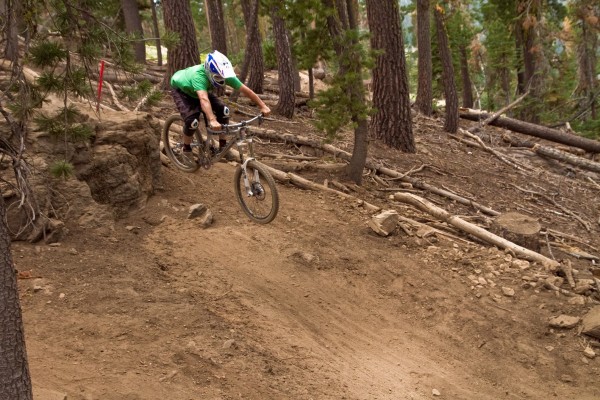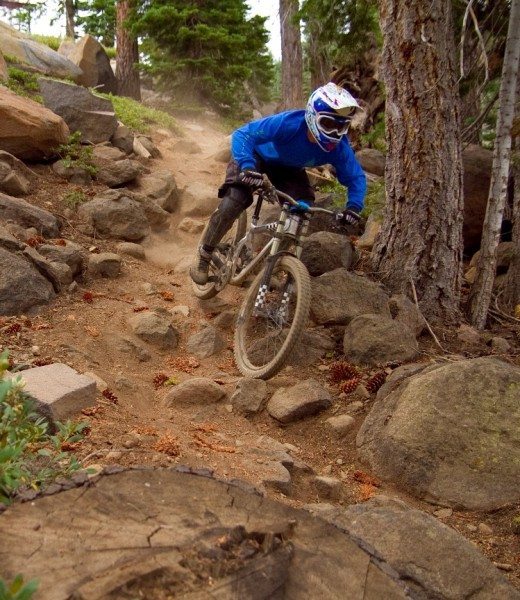Previous Turner owners will rejoice over how the suspension of the frame itself is designed. Turner has never built their DH bikes to utilize most of the travel all the time or in terms of the rider, for SMASHERS™. These new frames have a familiar ramp up in the suspension and are every bit as pumpable and poppable as their predecessors. For me personally, this was a big issue. It’s the one solitary thing I didn’t like about the old Iron Horse Sundays. I’m a fairly active rider who likes looking for places to pump to accelerate. The Sundays weren’t so hot at this. The DW DHRs are. The bonus is that at the end of the day when you’ve got a dozen runs under your belt, you can smash the living crap out of things and get away with it with this frame, which is something you’d be punished for on previous DHR models. Again, it’s not a plow bike necessarily, but it moves more in that direction from previous Turners without giving up the sweet lip-popping, doubled-up pumping efficiency.
The fit of this frame has a lot to do with my impressions of it, I’ll admit. Having been on several medium-sized Turners, they did something with this DHR that happened to suit me pretty well. Turner wanted a slacker headangle (63 to be precise) but they kept their wheelbases roughly the same from the previous models. What that did was shorten the cockpit just a tad. In a sport where there’s constant body position shifting from benchpressing over the bars to weight the front wheel, to shoving the bike in front of you to get the weight back, a shorter cockpit allows both of these extremes to happen to a greater degree. That shorter distance between the bars and feet (your two contact positions) allows you to both put the bike further in front of you because the stem is further back at static, and also pull your bars further back under your torso to weight the front. All this is included with a lower, slacker frame that inherently gives a more stable ride for a given wheelbase. Suspension aside, I dig the fit of this bike quite a bit.
That slacker headangle had a few people in a tizzy at first because, though some folks have been tweaking frames for years into that realm with their own modifications, not too many manufacturers had just come right out and done it with a stock frame. I’m a big proponent of looking at a wheelbase first and foremost on DH frames, because I honestly feel that has more to do with how big or small a bike feels than just about anything. Only second is horizontal distance between feet and headtube (which means feet to bars, again the two primary contact points on a DH bike).
My home mountain hosts some of the tightest, crappiest trails around, with more useless switchbacks in the wrong places (coupled with zero steepness) of just about any place I’ve ridden that was supposedly built for mountain bikes. I remember my first ride on this frame, and thinking that maybe it was going to be too much of a pig for all the slow, tight crap here. Not even close. All that headangle really translated into for me was that I could just hit shit harder head on while remaining centered over the bike, and especially at ludicrous speeds where it really matters. Seriously, that’s about it. I’ve still never felt like I needed to wrestle the bike around, even at Northstar. Not having to ride over the rear wheel as much really does translate into being able to stay centered on the bike and think about important things like where you’re going to put your front wheel next….There’s the obvious stuff, too, like riding a bunch of straight fall-line skidder junk in the pacific northwest proved how much more stable a slacker bike is, but you knew that already.
Not unique to Turner by any means, but the 1.5” headtube offers some tweaking options as well. You can stack a big fat headset in there to raise your bars and theoretically get a stiffer fork / frame interface, go flush and low, or do the angleset or angled cups route and go slacker or steeper. Mine is setup with a flush lower cup and a stacked up external cup on top to get the bars up a bit. The headtube on these is pretty short, so there’s lots of room to do whatever you want.





I LIVE IN TENERIFE, A HILLY PLACE.I LIKE TO PEDAL UP TO COME DOWN. I WANT TO BUY A TURNER DHR FRAME, I WONDER IF I COULD INSTALL A TWO RINGS CRANKSET, TO MAKE THE TURNER DHR MORE SUITABLE TO PEDAL UP ? I WOULD LIKE SOME ADVICES, THANKS
I’m not sure the DHR is really what you’d want for any kind of pedaling uphill Hugo. I’ve done it before with mine but just up some fairly mellow dirt roads. I mean it is a downhill bike. Maybe something like a Transition TR250 or a specialized enduro evo would be better.
Hi there
Can you post your settings on your boxxer world cup? How much sag and other thing.
I sold the Boxxer last year so I can’t check precise setting unfortunately. At 165lbs riding weight, I think I was running around 80psi for pressure with the bottom out volume reducer pretty much maxxed out. Those forks felt so spikey to me that I ran very minimal compression damping. I think just a few clicks in a low speed compression damping and literally no high speed damping.
That’s just on memory, sorry I couldn’t be more specific.